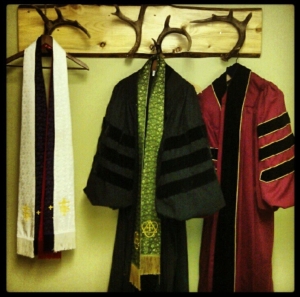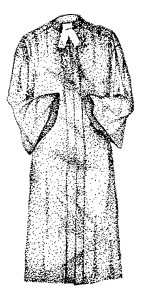 After a morning sermon on a warm day, I often tell people with a wink: Let me take off my dress here a minute.” So why bother wearing that robe, anyway? I wear it for both personal and professional reasons. The crimson gown that I wear on Christmas and Easter is my PhD
After a morning sermon on a warm day, I often tell people with a wink: Let me take off my dress here a minute.” So why bother wearing that robe, anyway? I wear it for both personal and professional reasons. The crimson gown that I wear on Christmas and Easter is my PhD
gown, made in the colors of Calvin Theological Seminary. My mother, who did not live to see my ordination or the completion of my theological studies, gave me the black Genevan gown and the colored stoles that I still wear today on most other Sundays. Most pastors don’t wear it anymore; others wouldn’t be caught in the pulpit without it. Obviously once can preach the gospel in a business suit or kakhi shorts, and on the hot sultry days of a Michigan summer I may set aside the robe for a time.
But come September, I will put my preaching uniform back on. In the Reformation, pastors traded the priestly garments of the Roman Catholic Church for the teaching dress used in schools. The robe then symbolizes the office of teaching the Word, as opposed to the former idea of a priest offering the sacrifice of the mass.
The professional reason is this: I intentionally and purposefully wear a Geneva gown for worship, in order to communicate to the congregation, and also to remind myself, that when I bring the Word, I am fulfilling a sacred office to teach the Word. My primary calling as a Minister of the Word is to teach the scriptures, to proclaim, explain, and apply God’s Word. It also very explicitly connects our contemporary ministry to our rich heritage in the protestant Reformation, and even more specifically to the Reformed tradition of Christianity (thus it is called the Geneva gown, after the Swiss city of Geneva where John Calvin served as one of the pioneering leaders of the Reformed church).
Like any symbol, it can be misinterpreted. It does not mean that the pastor is somehow above the congregation. It does not imply that the worship has to be more stuffy or rigid or formal. African-American pastors wearing Geneva gowns lead congregations in spirited, dancing, animated worship. Like any symbol, an individual’s past may color how one reacts to it: positively, if a beloved former pastor used it, or negatively, if one had less-than positive experiences with a robed minister, or if one (mistakenly) associates robes with Roman Catholicism. More importantly, the meaning of symbolism can change with new experiences. Wearing the robe is a statement: we are a Reformed church that is firmly rooted in the teaching of the Word.
 There is another part of the uniform that also communicates important messages. While the robe communicates the particularly Reformed idea of the seriousness of the office of preaching the Word, the colored stole that is commonly worn with it reflects the universal Christian tradition, and churches of various traditions and nationalities. The church around the world uses a common calendar, the church year, and there are colors associated with that calendar, such as white for the highlights of Christ’s life such as Christmas and Easter, red for the flames of Pentecost, royal purple for Lent and Advent, and green to symbolize growth in discipleship. Wearing the stole is statement: we are part of the one holy catholic and apostolic church of all times and places. Some people like it, others do not; but liking it is not the point. The weekly exercise of donning the robe is, for me and also others who see it that way, a tangible reminder of my calling and helps me to center my mind on leading God’s people in worship.
There is another part of the uniform that also communicates important messages. While the robe communicates the particularly Reformed idea of the seriousness of the office of preaching the Word, the colored stole that is commonly worn with it reflects the universal Christian tradition, and churches of various traditions and nationalities. The church around the world uses a common calendar, the church year, and there are colors associated with that calendar, such as white for the highlights of Christ’s life such as Christmas and Easter, red for the flames of Pentecost, royal purple for Lent and Advent, and green to symbolize growth in discipleship. Wearing the stole is statement: we are part of the one holy catholic and apostolic church of all times and places. Some people like it, others do not; but liking it is not the point. The weekly exercise of donning the robe is, for me and also others who see it that way, a tangible reminder of my calling and helps me to center my mind on leading God’s people in worship.

